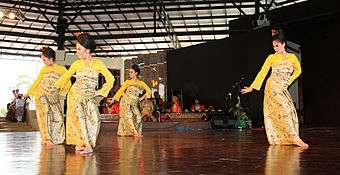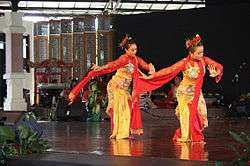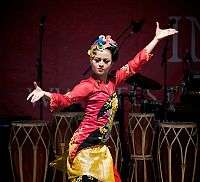Jaipongan
 Jaipongan Mojang Priangan dance performance | |
| Genre | Neo-Traditional |
|---|---|
| Inventor | Gugum Gumbira |
| Origin | West Java, Indonesia |
Jaipongan, also known as Jaipong, is a popular traditional dance of Sundanese people, West Java, Indonesia. The dance was created by Gugum Gumbira, based on traditional Sundanese Ketuk Tilu music and Pencak Silat movements.
Background
In 1961, Indonesian President Sukarno prohibited rock and roll and other western genres of music, and challenged Indonesian musicians to revive the indigenous arts. The name jaipongan came from people mimicking of the sounds created by some of the drums in the ensemble. Audiences were often heard shouting jaipong after specific sections of rhythmic music were played. Jaipongan debuted in 1974 when Gugum Gumbira and his gamelan and dancers first performed in public.
The most widely available album of Jaipongan outside of Indonesia is Tonggeret by singer Idjah Hadidjah and Gugum Gumbira's Jugala orchestra, released in 1987, and re-released as West Java: Sundanese Jaipong and other Popular Music by Nonesuch/Elektra Records.
Gugum Gumbira
Gugum Gumbira is a Sundanese composer, orchestra leader, choreographer, and entrepreneur from Bandung, Indonesia. After 1961, when the Indonesian President Sukarno banned all forms of western music and challenged his people to revive their cultural music, Gugum Gumbira made this task his own. In order to do this he studied the rural, festival dance music for twelve years. His result was jaipongan. He created his own recording studio in Indonesia called Jugala.
Gugum Gumbira was born in 1945 in Bandung, Indonesia. He attended college in Bandung where he majored in social and political UNPAD. Once he left college, he took up a position at the Ministry of Finance and later moved to Government Vehicles. He also lectured at the Academy of Finance until 1988.
He currently owns a recording studio called Jugala where he conducts his orchestra also called Jugala and a dance troupe that shares the same name. They travel around the world to perform. As the choreographer for Jugala, he met his wife, Euis Komariah, who was the singer for the orchestra and a dancer in the troupe.
Musical origins

Jaipongan, also known as jaipong, is a musical performance genre of the Sundanese people in the Sundanese language of West Java, Indonesia. Jaipongan includes revived indigenous arts, like gamelan, but it also did not ignore Western music completely despite the ban on rock and roll. It used its sensuality and the sensuality found in a traditional village music and dance, ketuk tilu. However, many believe it is something purely Indonesian or Sundanese in origin and style. It is developed predominately from rural folk forms and traditions as a purely indigenous form. The rise of cassettes and films has led to the popularity of the musical form of jaipongan. It has spread from its home in West Java’s Sunda, to greater Java and Indonesia. It can be seen as many regional varieties of gong-chime performance found through much of Indonesia. As also an urban dance form, it is based primarily on the village forms of ketuk tilu and on the Indonesian martial arts, pencak silat. The musical genre is largely influenced from ketuk tilu with traces of the masked theater dance, topeng banjet and the wayang golek puppet theater. Ketuk tilu is its biggest influence, as a traditional Sudanese musical entertainment form.
Gong-chime performance is characterized by such features as: use of an ensemble dominated by idiophones, metallophones and knobbed gongs. It is a stratified polyphony, with lower-pitch instruments playing parts of lesser density and all parts are structured colotomically around time-cycles. This can be found in traditional Indonesian gamelan. There is improvisation on certain instruments. The modes used are grouped into two broad types: slendro and pelog.
Ketuk tilu was a musical genre based on ritual and celebration in the villages of the Sundanese people, meaning three kettle gongs. It was known for complex drumming coordinated with equally dynamic solo female dancers. The music was performed for planting and harvesting rituals and later celebrated village life, circumcision and marriage, expressed fertility, and displayed sensuality, eroticism and even sometimes “socially accepted prostitution.” Ketuk tilu was very popular in the Sundanese villages, but the urban Sundanese considered it unrefined and inappropriate because the music involved males and females dancing together suggestively, or mixed dancing between men and ronggeng, or prostitutes. Ronggeng probably has existed in Java since ancient time, the bas reliefs in Karmawibhanga section on Borobudur displays the scene of travelling entertainment troupe with musicians and female dancers.
The cassette industry and its boom in Indonesia helped popularize jaipongan greatly and promoted regional styles rather than hurt them. Many learned the dance through cassette rather than the performance. The mass media have made jaipong ubiquitous. It has created competition in the styles of the drummers among ensembles. It has also helped to bring about many dance schools, altering dance and its label on females in West Java.
The song repertoire of jaipongan is varied, and that is why it is better understood as an intertwined performance style of music and dance. Many songs are associated with ketuk tilu or other wide reaching regional varieties, not traditional gamelan. It consists of songs of more recent origin often composed for jaipongan. Song topics vary, encompassing amatory, moralistic, bawdy, topical and spiritual subjects, often emphasizing grass roots culture.
Instrumentation & choreography
Jaipongan is "a more slick and expanded version of ketuk tilu".[1]
Jaipongan takes much of its instrumentation from ketuk tilu ensembles. The ketuk tilu group is composed of pot-gongs. Besides the core three main kettle gongs (ketuk, tilu meaning three), the instruments include a rebab, a small upright bowed instrument, also known as a spike fiddle, other small gongs — a hanging gong and two iron plates, and two or three barrel drums. The traditional singer is female or a sinden, but also dances and invites men to dance with her sensually, so it is assumed she is a prostitute or ronggeng. The ensemble is small enough to be carried from village to village to places where a saron or kempul may be added.
Gumbira took and retrofitted the dynamic and intense ketuk-tilu music. The role of the singer was emphasized to concentrate just on the vocals. He added to it traditional gamelan by expanding the drum section of the ketuk tilu as more of an urban, unique gamelan orchestra from two drums to six. He also sped up the music significantly, increasing the dance role. He also modified the accompanying dance. The modifications retained some of the original sensual moves of ketuk tilu, joining to them a popular martial art called pencak silat. Gumbira called it jaipong. Jaipongan cassettes really feature the singer with their name and alluring cover photos. The singer is given greatest prominence, no longer seen as a prostitute but professional and respectful. This goes with the market demand for solo-superstars.
The idiophonic accompaniment of jaipongan may also include a few saron or a gegung (an L-shaped row of gong chimes), and often a gambang (xylophone). Otherwise instruments are the same as in ketuk tilu.
The melodies are set to madenda, the Sundanese variant of the pelog mode, or slendro, or a free combination of the two, or an alternating combination. The melodies are usually in the pelog or madenda scales, while the fixed pitch idiophonic accompaniment is strictly in slendro. This combination contrasts with the gamelan tradition. The scales of these modes, intonation and tonic are difficult and not consistent.[2] Intonation may be further obscured by the characteristic vibrato. These melodies in jaipongan can also be stereotypical; so much of the expressiveness and uniqueness comes in the introduction, improvised or pre-composed. It often establishes the modal pattern.
The verses are often organized into quatrains, each is one gong cycle, and in rhyme scheme aabbcc, each line having about eight syllables, as in most Sundanese folk and popular verse.
Social implications
In 1961, the president of Indonesia, President Sukarno created a ban on western music, mainly the genre of rock and roll, due to the fact that western ideas, themes, values and morals began to infiltrate the area. With the ban, Sukarno urged the public to “return to and revive the musical traditions of the past”. Gugum Gumbira heard this and decided to create a genre of music that would revive the musical interests of the past and added sexual undertones and a sense of elegance in order to bring it into the future. In addition to being a musical reincarnation, jaipongan also reincarnated martial arts and traditional dance. It became so popular that the government decided that it needed to be taught to be people of all generations.
When jaipongan was first introduced in 1974, there was a lack of acceptable music in the area of West Java—Sunda more specifically. It gained popularity instantly because it was a completely non-western form of music that the government accepted and promoted. It had all of the values of traditional Sundanese music to entice the older generations, yet had enough energy, vibrancy, and sexuality to entice the younger generations. Jaipongan was also based on the life of the lower class and elevated their stories and struggles. It allowed the people to see themselves in the music and feel as if they were a part of their culture. Once it became popular, many other musicians began recreating it.
When situations in Sunda became more political, the music shifted and took on themes of moral, political, social, spiritual awareness. Once the shift occurred, the government tried its best to end jaipongan. Due to its popularity with the people, it was able to maintain its craze, and even outlasted the ban on Western Music.
The sexual nature of the songs was taken from the idea of prostitution, and was then elevated in order to make it a more elegant, civilized part of art. This broke gender barriers because it changed the way in which men and women interacted. Never before had men and women danced or interacted together in promiscuous or sexually explicit or suggestive ways in performance in Indonesia. Even though jaipongan was created to stay away from musical themes of sex, love, drugs, and rock and roll, it incorporated some of these themes in small increments. When the government discovered the sexual nature of the songs and dances, they looked to curb the popularity of jaipongan, but it had already become the music of the people and their efforts were thwarted.
Jaipongan was a way for the Sundanese people to take back their culture from the Western ideas and rid themselves of the colonial Dutch influences. Jaipongan elevated the idea of village music or music of the people. It focused on love, money, agriculture, and as the world became filled with more turmoil, it became a vehicle for moral, political spiritual, and social awareness.
Jaipongan became so popular that in 1976, two years after its creation, it was recorded on cassettes on Gumbira’s record label Jugala. With the cassette’s release international popularity rose and helped to create a larger musical industry in Sunda and Indonesia at large. All of which was and still is used to help preserve the culture and history of the West Java and the Sundanese people.
The rapid popularity of Jaipongan along with the boom in cassette tapes helped the genre to spread and become popular in Asia, Europe, and America during the 1980s. In addition it created a tourism industry in Sunda. People from all over the world came to learn about and experience Jaipongan first hand. Music and dance schools were created in order to preserve the art form and history of the Sundanese people. The government felt that Jaipongan was such a cultural staple that it needed to be taught to all citizens.
Jaipong today

In 2011, the international popularity of jaipongan has decreased, but in Asia, the genre still extremely popular. It is most popular in the areas of Sunda, where it was created, as well as the surrounding villages and cities.
Although the genre is most popular in Asia, there are jaipongan dance troupes and musical ensembles in Europe in addition to the United States (like Harsanari of San Francisco, California) and throughout other parts of the world. Dutch-Indonesian choreographer Gerard Mosterd devised a modern dance choreography, "Ketuk Tilu" in 1998. Approved and inspired by Gugum Gumbira. Based on a classic recording with Euis Komariah and Jugala Orchestra.
In 2015, jaipongan was noted as a modern classical genre of music, which is often utilized in other Asian music, and has multiple subgenres. There is still is a large market for jaipongan recordings. However, few years ago fundamentalist political proposals were submitted to blacklist jaipongan and several other 'sensual" Indonesian dance forms.The ban attempt didn't succeed and jaipongan remains a very popular underground genre associated with erotic and rebellious power instead.
Film
The mass media has helped jaipongan become popular especially in the cinema but not as much as cassettes. There are many filmed performances online from students/audiences and dance documentaries from Java/Indonesia. Jaipongan songs have been taken and set to Mr. Bean, a character created by Rowan Atkinson, and other modern popular cultural references in YouTube videos.
Music videos and performances of Tonggeret by Idijah Hadijah as well as other famous artists can be seen on YouTube and also can be heard and referenced in use by Indian film songs. There is a full-length film called Mistri Ronggeng Jaipong from Indonesia, which was made in 1982 by Mardali Syareif.
There is also a Jean Hellwig film on popular dancing in West Java, from 1989, with accompanying book and jaipongan chapter called Sundanese Pop Culture Alive.[3] A snippet can be seen in the reference section.
Popular artists
- CBMW (Bandung Music Group)
- Jugala Orchestra
- Detty Kurnia
- Yayah Ratnasari & Karawang Group
- Idjah Hadidjah
See also
References
| Wikimedia Commons has media related to Jaipongan. |
- ↑ Manuel, Peter (1990). Popular musics of the non-Western world : an introductory survey. Oxford University Press. p. 214. ISBN 9780195063349.
- ↑ . 18: 91–110. JSTOR 834160. Missing or empty
|title=(help) - ↑ https://books.google.com/books?id=q6cI8dgo6G4C&pg=PA47&dq=jaipongan&hl=en&ei=lMK4TaT1LMLTgAfpw-Rz&sa=X&oi=book_result&ct=result&resnum=1&ved=0CCkQ6AEwAA#v=onepage&q=jaipongan&f=false Jaipongan
- Jaipongan dance created by Gugum Gumbira in West Java Short MOV video from a Jean Hellwig film on popular dancing in West Java (1989)
Cultural Context, Musical Origins, Instrumentation, Choreography taken from:
- Manuel, Peter, and Randall Baier. "Jaipongan: Indigenous
Popular Music of West Java." Asian Music 18.1 (1986): pp. (91-110). Web. 29 Mar 2011. <http://www.jstor.org/stable/view/834160>.
- Yampolsky, Philip. "Tonggeret: Jaipong Sunda; Idjah
Hadidjah." Asian Music 21.2 (1990): pp. (166-170). Web. 29 Mar 2011. <http://www.jstor.org/stable/834120>.
- "Jaipongan: Indigenous Popular Music of West Java."
Harsanari: Indonesian Dance Company. 2011. Web. 29 Mar 2011. <http://www.harsanari.com/jaipongan.htm>.
- "Jaipongan Music with Idjah Hadidjah." Java Sounds.
2009. Web. 29 Mar 2011. <http://www.javasounds.org/jugula.html>.
- "Modern dance inspired by Jaipongan created by Dutch-Indonesian choreographer Gerard Mosterd. Duet from "Ketuk Tilu" 2015 version, Kuala Lumpur International Arts Festival" Java Sounds.
2015. Web. 17 Oct 2015. <https://www.youtube.com/watch?v=zqPXaRD9mSE>.
Social Implications, Where it is Now taken from:
- Arps, Bernard. Performance in Java and Bali: studies of narrative, theater, music, and dance. London: The school of Oriental and African Studies, University of London, 2005. Print.
- Lockard, Craig. "Indonesia." Dance of Live Pop Music and Politics in Southeast Asia. USA: University of Hawai'i Press, 1998. 91-110. Print.
- McConnachie, James. "Indonesia." The Rough Guide to World Music Volume two, Latin, North America, The Caribbean, Asia, and the Pacific. Shorts Garden, London: Rough Guides, 2000. 130-142. Print.